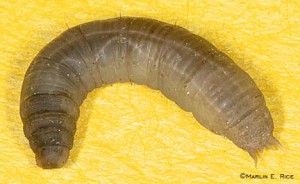Temperatures over the last week were certainly what you would expect for early June, yet we have almost accepted there is no such thing as the norm anymore. Sprayers have been busy this week but care must be taken not to spray in strong sunlight. It has been very frustrating for farmers trying to grab any available opportunity to spray crops; it was too wet, too windy and now too hot! Any weed control onto potatoes and veg should be delayed as drier conditions remain and residual herbicides require moisture to work effectively. Many farmers have been at silage this week with crops bulking out very well.
SPRING CEREALS
The above average rainfall over winter has depleted many soils and it is essential to replace essential nutrients. Spring barley crops grown on low PH soils with a low P index seem to be struggling most this season. This must be rectified with lime and Phosphate fertilizer in accordance with soil analysis. Leather jacket damage is still occurring in later drilled crops and should continue to be monitored. This pest coupled with poor germination of seed due to cool soils has left many bare patches in fields at present.
An application of a balanced and rapidly available source of macro & micronutrients at this key time will minimise the adverse effects of restricted soil nutrient uptake. CEREAL HIGH N supplies 3.7%Mn, 1.5%Mg, 1.8%Cu, and 0.6% Zn in the most rapidly available form to plant through the leaf and also supplies high levels of Nitrogen and Sulphur. Potash deficiency is also showing up in many spring barley crops with pale green yellow tips being the first symptom. Deficency is most likely on light sandy soils or in crops following intensive grassland. Manganese deficiency is also appearing on crops especially where lime has been applied recently. A foliar application may be applied along with the weed control.
To minimise the effects of competition on the crop and optimise the level of weed-control, herbicide application should be carried out at the earliest opportunity, once all the weeds have emerged but are still small, and before they begin to compete with the crop for nutrients and light. With low soil temperatures since drilling, weeds are not coming through as rapidly as expected but chickweed is beginning to choke out young plants and must be sprayed as soon as possible.
Product choice will depend on the weed type and size present and the crop growth stage. Broad-leaved wise, Sulfonyl-urea (SU) herbicides will likely be the starting point, controlling a wide range of weeds and very safe to the crop. Options include ALLY MAX covering a wide spectrum of BLW with the max formulation giving improved control of polygonums & other BLW over the old ALLY formulation. HARMONY M SX controls a wide range of BLW at sizes larger than any other sulfonyl-urea herbicide. HUSSAR is being used on spring barley to control grass weeds, however this must always be tank-mixed with another BLW herbicide to control SU resistant weeds (chickweed) and those weeds not controlled by the SU’s (cleavers, fumitory& fat-hen). Ideal partners are COMPITOX controlling chickweed, fat-hen & fumitory, or OXYTRIL CM controlling field-pansy, red dead-nettle and speedwells and SPITFIRE /MINSTRELfor chickweed and cleavers.
Where the range of BLWs present are limited to chickweed, redshank, fat hen, fumitory & day nettle, the hormone mixture products will work well without the need to tank-mix, but must be applied by GS31. Where the likes of field pansy, forget-me-not, speedwells & corn-marigold are also present, sulphonyl-ureas products will improve control. AXIAL gives excellent control of wild and tame oats in spring barley and spring wheat and has an excellent window of opportunity. Application should be held off until at least 6 weeks after drilling to ensure all wild oats have germinated. It can then be applied up to full flag-leaf of the crop and full flag leaf of the wild oatGS39, allowing a minimum of 21 days to have elapsed after application of the BLW herbicide. The wetter ADIGOR must be used in all situations along with the AXIAL.
WINTER WHEAT
Most crops are now moving through the stages of stem elongation with more forward crops at flag leaf. Septoria tritici is present in most crops at variable levels depending on T1 timing but with recent weather; expect levels to rise if fungicide rates and timings are not correct.
As the flag leaf will be emerging in most crops within the next week or two it is the key time to apply the T2 treatment. Of all fungicide treatments, T2 has the greatest impact and response in terms of grain yield and quality, keeping the top three leaves clean and the ear as it emerges. The dose rate applied must be sufficiently robust to ensure long term protection of the flag leaf plus eradicate disease already present on the lower two leaves that also contribute to yield. Prothioconazole in PROSARO or BRUTUS (epoxiconazole + metconazole) will form the key part of the T2 fungicide onto winter wheat. Growth regulator must also be applied at this time where required.







